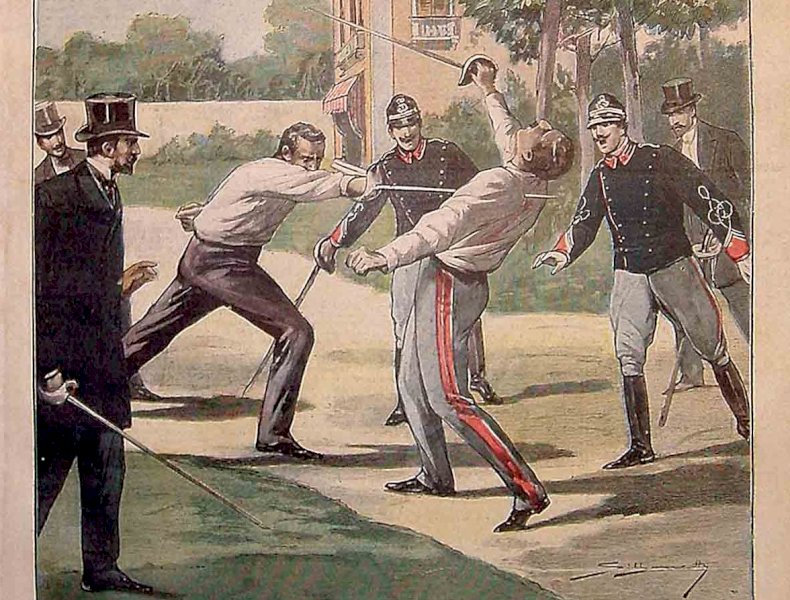Here a duel that happened in my town in the 1896.

in the photo: the cover of La Tribuna Illustrata dedicated to "The tragic duel of Savigliano".
When a newspaper article could cost a life: the 1896 duel of Savigliano In the last part of the nineteenth century the dispute between a journalist and an officer ended in the blood. But it is only one of the many cases in which the pen is passed to the sword
It was the late afternoon of September 15, 1896 when in a building in Savigliano, on the road to Marene, the lawyer Attilio Vinardi, director of the Gazzetta di Savigliano, and Lieutenant Alessandro Zemos of the 17th Cavalry Regiment "Caserta". The duelists are accompanied by their respective godparents: for the journalist, Cavalier Calieri, director of the Turin periodicals Il Fischietto and La Luna, and Mr. Sapelli, editor of both newspapers. For the officer, Lieutenants Gelmi and Guiscaroli. At 6 pm he echoes the command "to them!" and the contenders cross the blades. The chronicle of the event is entrusted to the words of Jacopo Gelli, author of a precious compendium on The deadly duels of the nineteenth century: "The saber was chosen, with no holds barred, on the condition that the fight would cease, when the doctors declared that a of the duelists were unable to continue in the fight ". The challenge was immediately bloody: “The two adversaries attacked each other with extreme violence; but in the first assault both were unharmed. At the third warning, with the attack no less violent than the previous ones, Lieutenant Zemos received the opponent's tip in the left side and fell lifeless to the ground. The opposing weapon had pierced him from side to side, rending his heart ". Colonel Gelli, author of a well-known chivalric code and tenacious opponent of the institution of the duel, deplores in no uncertain terms the fact that" the four godparents affirmed that the duelists had behaved according to the most rigorous rules of the cavalry! ”. But what offense had caused the bloody event, immortalized by the cover that La Tribuna Illustrata on Sunday 27 September 1896 will dedicate to the “tragic duel of Savigliano”? The background dates back to January of the same year, when - following friction between the Saviglianese population and the regimental officers stationed in the city - Vinardi had sent a short correspondence to a satirical newspaper in Turin, La Luna. The director had not considered it appropriate to publish his correspondent's piece and had set it aside, perhaps with the intention of later returning it to the author. Except that in early September, in the absence of the director, the paper had landed in the hands of one of the editors of the paper, who had published it without the knowledge - at least it seems - of Vinardi himself, who no longer remembered having sent the correspondence The article contained some allusion to Lieutenant Zemos, a young 33-year-old officer, originally from Courmayeur in the Aosta Valley, who had earned his shoulder pads starting as a simple soldier. Feeling offended, the lieutenant sent to challenge the director of the Moon who replied that he was ready to accept the duel if Vinardi declined responsibility for the article. But the latter declared himself very ready to give satisfaction to his challenger, ending up killing him: "That same evening - notes Gelli - while the lawyer Vinardi gained the border, the body of the unhappy Zemos entered the military hospital, arousing immense, painful compassion ". Of the journalist, who first fled to Spain, it is known that he died on French soil seventeen years later, in 1913. In the meantime, for another of the numerous short stories in which he attacked the military garrison of Savigliano, he had been sentenced on charges of a certain Biancotti-Sassini lawyer, Genoese notary and complement officer of the “Caserta” cavalry regiment. The court of Saluzzo sanctioned him for insult and defamation with the penalty of 10 months in prison and a fine of 883 lire. The sentence was then increased to 18 months of imprisonment and a fine of 1500 lire by the Court of Appeal. The pen kills more than the sword: the "journalistic duel" between the nineteenth and twentieth centuries To face each other in the Saviglianese challenge they are as a military man said and a journalist, or representatives of the two categories who were most likely at that time to let the blood flow for an offense - real or alleged. To testify is Gelli himself, an absolute authority in the field: "To be convinced of this - he writes in the preface of his volume, published in 1899 - just take a look at the statistics of the duel that I have compiled for over twenty years and it will be revealed that the presumed causes of the clashes are to be attributed first to journalistic controversies, then to squabbles, then to political disputes, as if the good government of a state was concentrated on the sharp point of a sword, or on the sharp edge of a saber ".